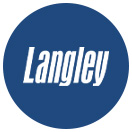When you hear “It’s not about the money,” you probably smile and think of Jessie J’s hit song, Price Tag. But when it comes to applying to colleges, oh yes—money is a huge part of the conversation. And while there are so many factors that go into choosing the right college for you, cost is one you can’t afford to overlook. The difference is how you let it steer you (or not).
You’ve worked so hard. You’ve nailed your classes, maybe played sports, joined clubs—or maybe you’re still figuring out what “your thing” is. You dream of walking across that stage, earning your degree, and launching your career. But hold up: that dream often comes with a price tag, and unless you see it clearly, you might be in for a rude awakening.
But never fear, because Langley is here to dig into the real costs of attending college, before you commit to your dream school. Let us show you how scholarships, grants, and smart financial planning can turn that cost from seemingly impossible to manageable!
The True Price Lays in More Than Just Tuition
If your estimated tuition package reads “20,000 per year” (sometimes double if you attend college out of state), that often includes tuition + fees + your room. But that’s not everything. You also need to consider:
- Transportation (your car, gas, or plane/bus/train tickets home)
- Technology (college usually requires you to have your own laptop)
- Potential tuition increases each academic year
- Necessities like books, laundry, and a meal plan (especially when those late-night cravings start to hit)
Bottom line: tuition might be the biggest expense, but it’s only one piece of the puzzle, so don’t forget to plan for all of those additional costs!
Let’s look at the big picture:
- Nearly 85% of undergraduate students receive some form of financial aid (grants, scholarships, federal loans). (National Center for Education Statistics)
- In 2022-2023, U.S. Federal Student Aid disbursed over $112 billion in grants to students. (Federal Student Aid)
- Many students find it difficult to attend their chosen college unless the financial package matches their needs.
Translation: the ability to afford a university doesn’t come mainly from sticker price, it comes from how much you don’t have to pay after aid.
If students neglect to apply for financial aid, they leave free money on the table. So jump into that process early!
Scholarships, Grants, and FAFSA: The Keys to Paying for College
If you’re only depending on savings and family contributions, you’re fighting with one hand behind your back. Here’s how financial aid works (and how to maximize it).
Scholarships + Grants = Free Money
Unlike loans, you don’t have to pay these back. They’re gold.
These are not small gestures. If just a few extra students qualify or compete, that could shift their college path entirely.
Tip: Make sure to apply widely! Small local scholarships often have fewer competitors.
The FAFSA Gateway
What Happens After Aid?
Even after grants and scholarships, there is often a gap. That’s where borrowing or additional savings come in.
Our Private Student Loan Solutions are designed to fill the funding gaps that may exist after all other sources of aid (federal loans, scholarships, grants, etc.) have been exhausted.
Borrowing Wisely and Refinancing Later
If you end up needing loans, borrow them smartly. Here are a few paths and pitfalls:
Federal Student Loans
These usually come with benefits:
- Fixed interest rates: your interest rate stays the same over the life of the loan, so your monthly payments won’t unexpectedly increase.
- Income-driven repayment options: your monthly payments can be based on how much money you earn, making it more affordable if your income is lower.
- Deferment or forbearance in hardship: if you lose your job, face illness, or go through financial trouble, you may be able to temporarily pause or reduce payments until you get back on your feet.
- Subsidized loan options for eligible undergraduate students. The government pays the interest on certain loans while you're in school, during the grace period, and during deferment—helping you avoid interest buildup early on.
Private Student Loans
Langley’s private student loans are structured to cover your remaining gap.
We offer:
- A line of credit structure that lets you secure funding for your entire undergraduate or graduate career upfront, so you’re not left reapplying each year or worrying about who will approve you next.
- No origination or prepayment penalties, meaning you won’t be charged extra fees for taking out the loan, and you can pay it off early without any financial penalty.
- Flexible repayment and in-school deferment options, so you can adjust how you pay back the loan, and if you’re still in school, you may be able to delay making payments until after you graduate.
But note: private loans often depend on credit and may have variable rates or fewer protections compared to federal loans. So no matter who you borrow from, read their terms carefully.
Refinancing and Consolidation
After you graduate, you might want to refinance or consolidate loans to lower your interest rate or combine payments. Langley offers Student Loan Refinancing options, with rates starting as low as 4.49% APR, helping you lower your overall borrowing costs and potentially save thousands over the life of your loan.
How Planning Pays Off
Let’s walk through a few hypothetical (but realistic) scenarios of how planning can be a life vest for you and your academic journey:
Scenario A: The Overconfident Saver
- You expect to attend your dream college, and tuition is $45,000/year.
- You decide to save $5,000/year during high school (so $20,000 total).
- You and your family assume “the rest” can be borrowed later.
But at your dream school, you only earn $8,000 in scholarships and grants. Now your gap is $37,000 per year × 4 = $148,000. After subtracting your $20,000, you must borrow $128,000.
That’s a heavy debt burden, especially if your major’s starting salary is in the $50,000-$60,000 range.
Scenario B: The Strategic Maximalist
- Same school, same costs.
- But you aggressively pursue scholarships—local, regional, thematic (for your major, background, hobbies). Suppose you earn $15,000/year in non-loan funding.
- You also use Langley's Save for College Calculator and realize that you actually need to save $7,000/year rather than $5,000.
Your gap falls to $30,000/year × 4 = $120,000. With $28,000 saved, you borrow $92,000. That’s $36,000 less than in Scenario A, and every dollar you reduce in borrowing is money not going toward years of interest.
Compare: $92,000 in loans at 5% interest over 10 years is about $974/month in payments (depending on terms). If you’d borrowed $128,000, that’s more like $1,355/month. That’s not just math, it’s life choices (job, location, stress).
Dream Big, But Budget Hard!
Dreaming of that perfect campus, ideal major, or having a successful career? Go for it. But let your dream rest on a sturdy financial foundation. Use every tool, scholarship, calculator, and coach available, including those at Langley to bridge the gap between ambition and affordability.
If you let “It’s not about the money” be your mantra without doing the work, your debt could become the story you didn’t intend to tell. But if you start early, let budgeting be your guide, and treat financial aid like a treasure hunt (because it is), then your debt can remain a strategic tool, not a life sentence.



